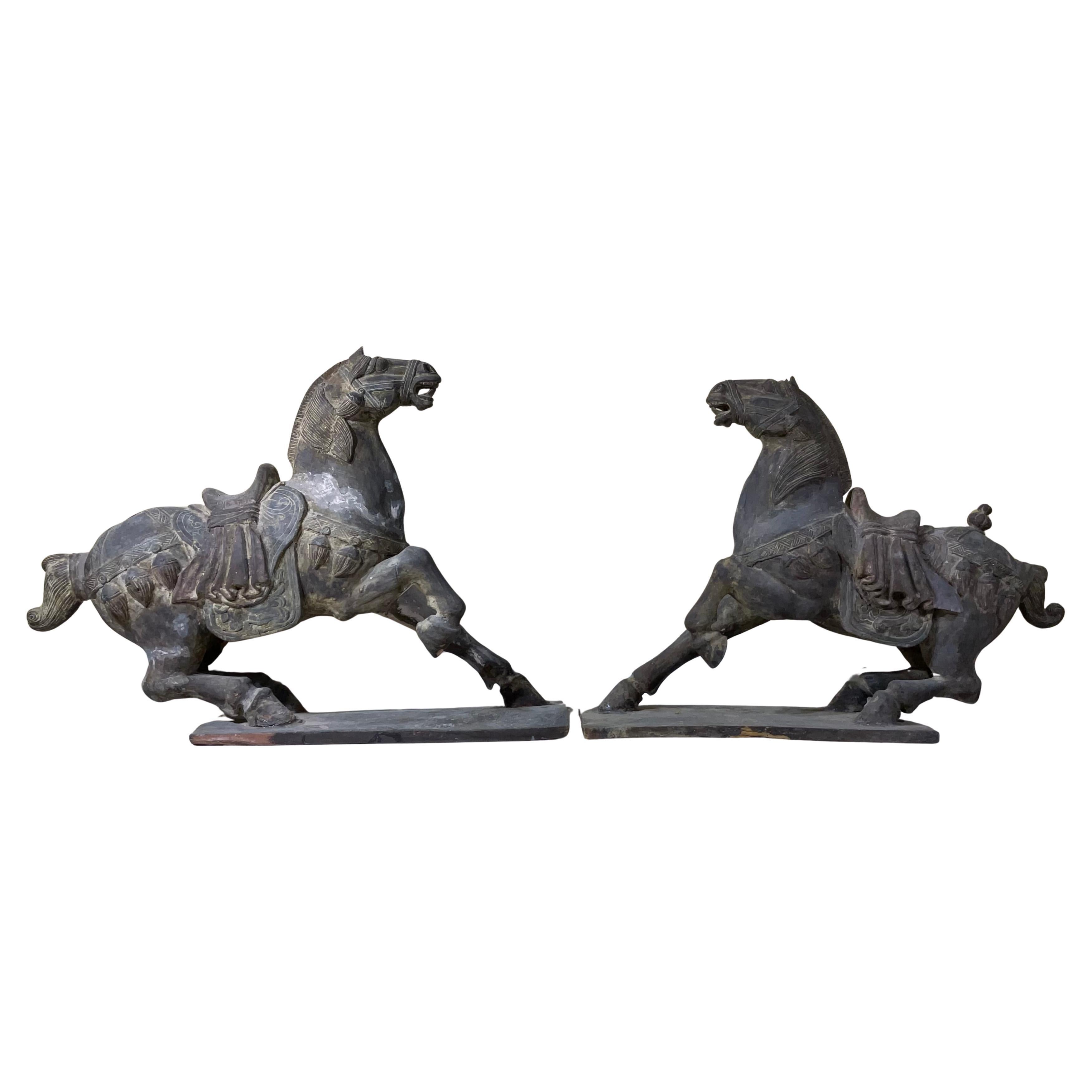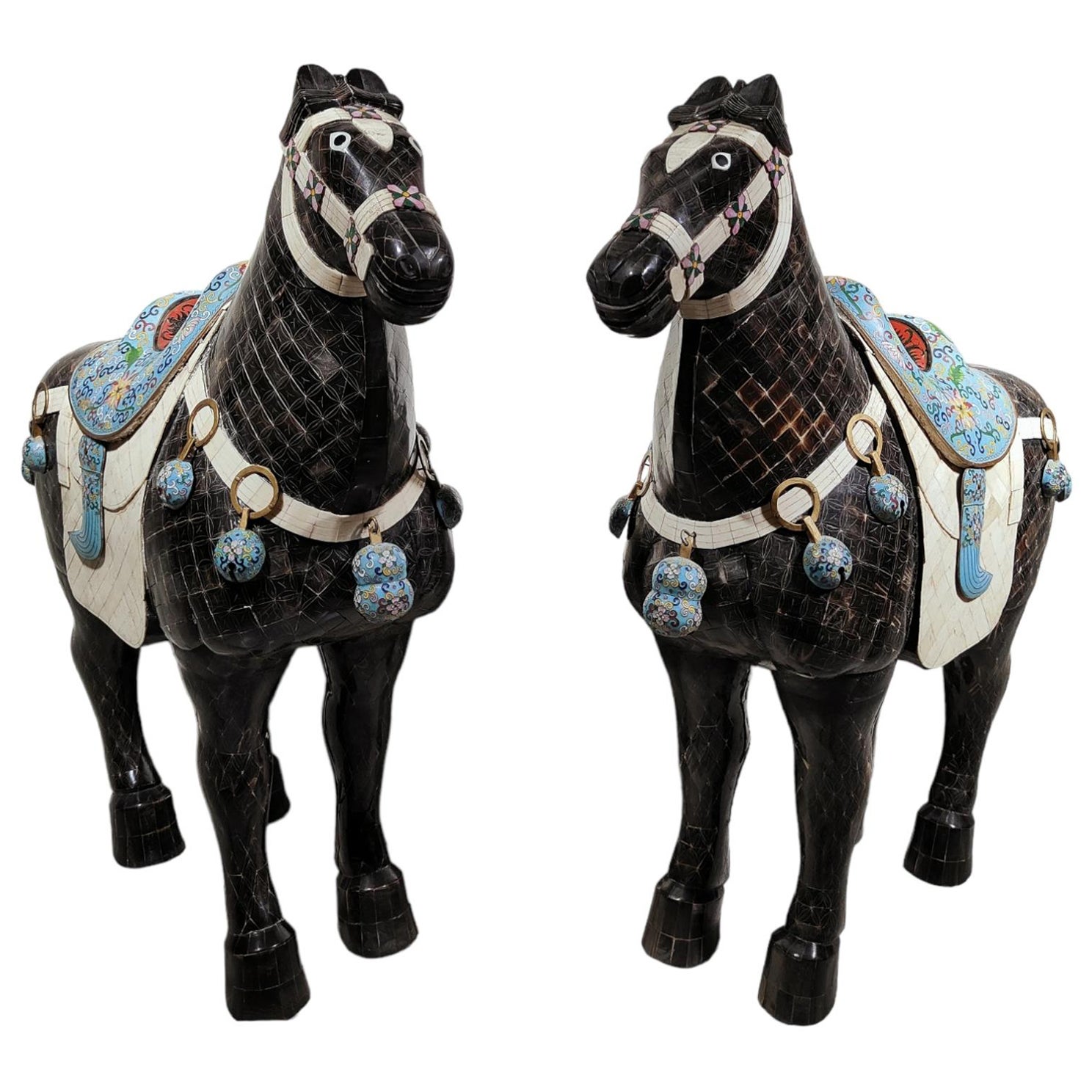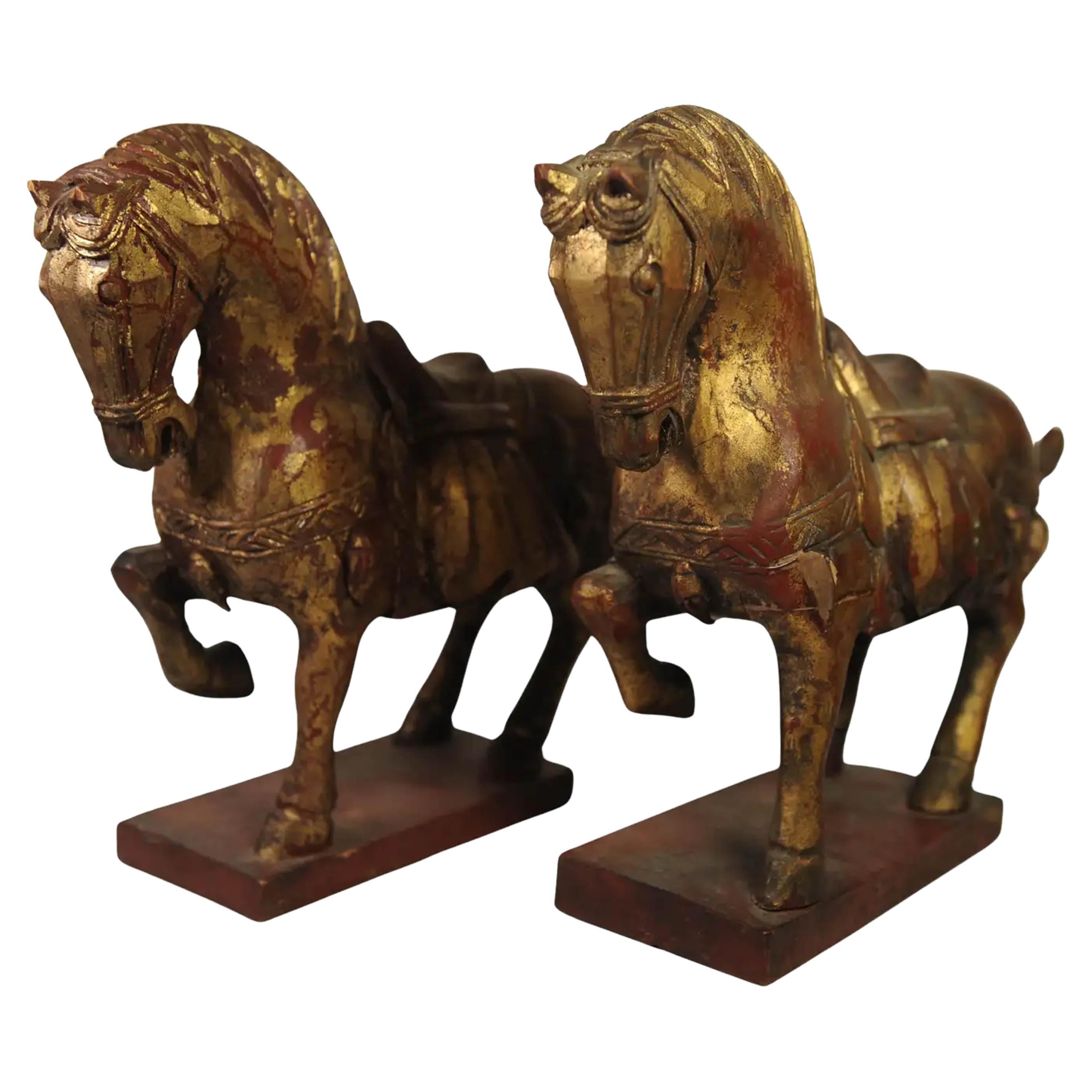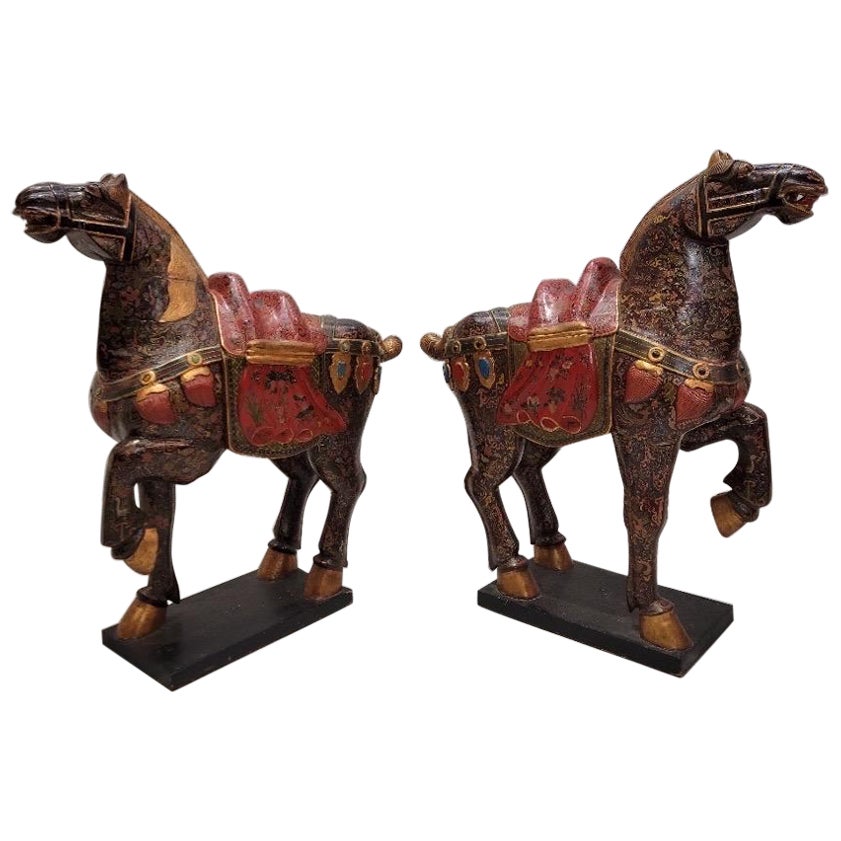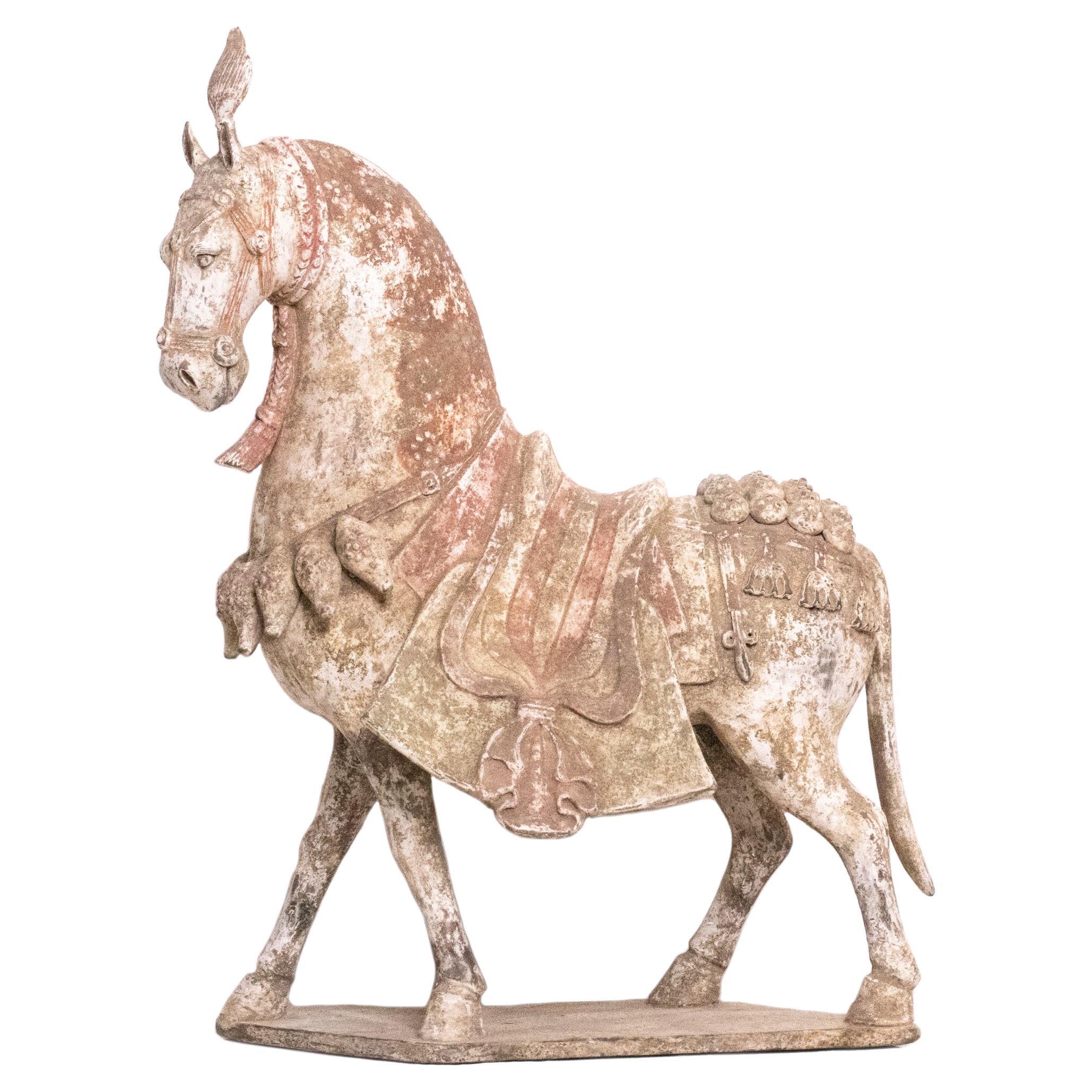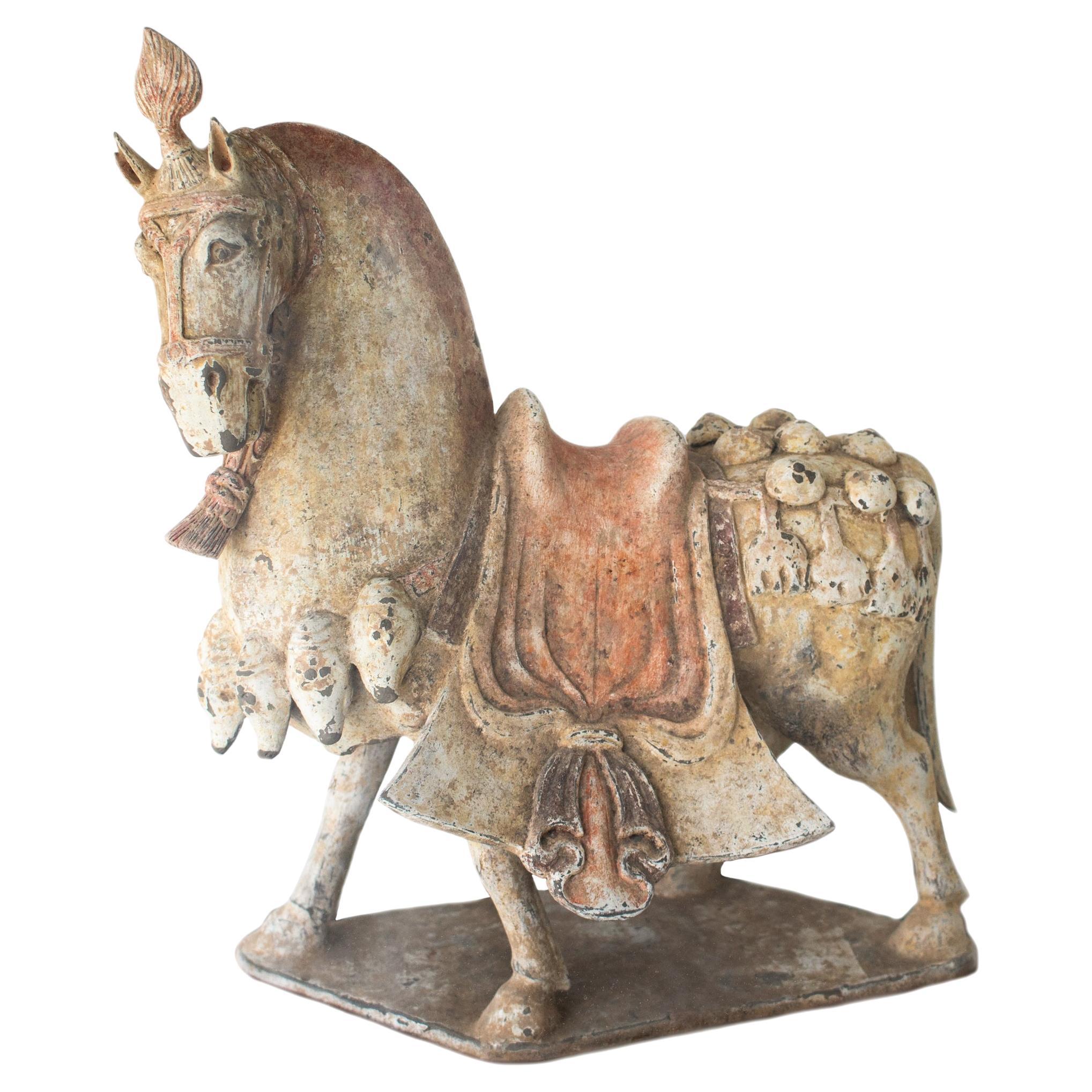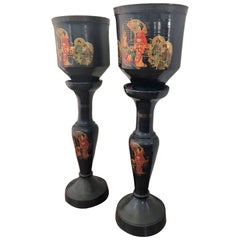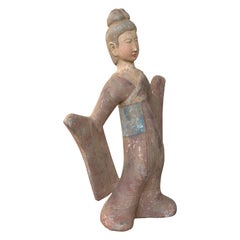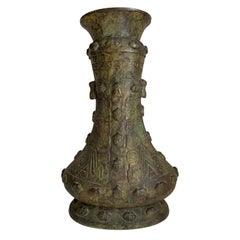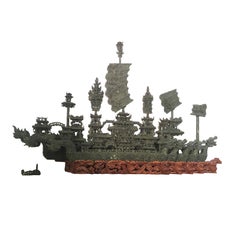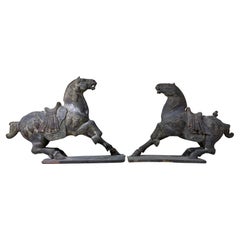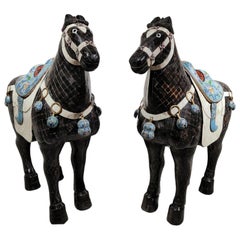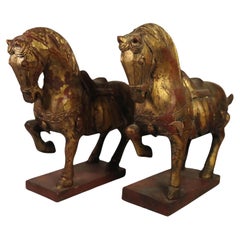Items Similar to Northern Wei Dynasty Terracotta Horses, TL Tested, '386 AD-535 AD'
Want more images or videos?
Request additional images or videos from the seller
1 of 21
Northern Wei Dynasty Terracotta Horses, TL Tested, '386 AD-535 AD'
$185,000per set
£140,373.74per set
€160,504.82per set
CA$258,394.84per set
A$287,299.90per set
CHF 150,012.16per set
MX$3,497,139.36per set
NOK 1,914,089.77per set
SEK 1,793,410.65per set
DKK 1,197,877.04per set
Shipping
Retrieving quote...The 1stDibs Promise:
Authenticity Guarantee,
Money-Back Guarantee,
24-Hour Cancellation
About the Item
A massive pottery pair of horses standing on all fours and striding with its right hoof forward. Extended snout ends in parted lips showing teeth beneath in a braying attitude. Low relief bridle on face and well defined eyes. Raised mane down back of the neck
A fantastic example of the Wei dynasty horses.
Large, exquisite walking Ferghana horses with great attention paid to anatomical detail were the choice of the wealthy. The horse was second only in importance to the dragon. It was supposed to possess magical powers which the early Chinese were eager to explore. It would be the horse that would carry the deceased to the next life and it would be the amount of horses that an individual owned that would guarantee his ongoing status in the hereafter.
Thermoluminescence certificate from Madrid Labs included.
In southern China, people turned to Daoism, and mingqi, as well as above-ground sculptures, became ever more infused with animal iconography and energized with dynamic lines.
The north of China was eventually united by nomadic Tuoba invaders who founded the Northern Wei dynasty (386-534) and established a measure of stability. Their rule fostered both preservation, seen in Han tomb styles and funerary practices, as well as innovation, seen in new types of mingqi such as human-faced guardian animals called zhenmushou, human guardians, and increasing numbers of pack animals and military figures.
The Northern Wei or the Northern Wei Empire (/we?/), also known as the Tuoba Wei (???), Later Wei (??), or Yuan Wei (??), was a dynasty founded by the Tuoba (Tabgach) clan of the Xianbei, which ruled northern China from 386-534 AD (de jure until 535), during the period of the Southern and Northern Dynasties. Described as "part of an era of political turbulence and intense social and cultural change", the Northern Wei Dynasty is particularly noted for unifying northern China in 439: this was also a period of introduced foreign ideas, such as Buddhism, which became firmly established.
During the Taihe period (477-499) of Emperor Xiaowen, court advisers instituted sweeping reforms and introduced changes that eventually led to the dynasty moving its capital from Datong to Luoyang, in 494. The Tuoba renamed themselves the Han people surname Yuan (?) as a part of systematic Sinicization. Towards the end of the dynasty there was significant internal dissension resulting in a split into Eastern Wei and Western Wei.
Many antiques and art works, both Taoist art and Buddhist art, from this period have survived. It was the time of the construction of the Yungang Grottoes near Datong during the mid-late 5th century, and towards the latter part of the dynasty, the Longmen Caves outside the later capital city of Luoyang, in which more than 30,000 Buddhist images from the time of this dynasty have been found.
- Dimensions:Height: 23.42 in (59.49 cm)Width: 11.81 in (30 cm)Depth: 20.47 in (52 cm)
- Sold As:Set of 2
- Style:Han (Of the Period)
- Materials and Techniques:
- Place of Origin:
- Period:
- Date of Manufacture:300-600 AD
- Condition:Wear consistent with age and use.
- Seller Location:Miami, FL
- Reference Number:1stDibs: LU1726217808752
About the Seller
4.7
Platinum Seller
Premium sellers with a 4.7+ rating and 24-hour response times
Established in 1995
1stDibs seller since 2015
1,286 sales on 1stDibs
Typical response time: <1 hour
- ShippingRetrieving quote...Shipping from: Moncada, Spain
- Return Policy
Authenticity Guarantee
In the unlikely event there’s an issue with an item’s authenticity, contact us within 1 year for a full refund. DetailsMoney-Back Guarantee
If your item is not as described, is damaged in transit, or does not arrive, contact us within 7 days for a full refund. Details24-Hour Cancellation
You have a 24-hour grace period in which to reconsider your purchase, with no questions asked.Vetted Professional Sellers
Our world-class sellers must adhere to strict standards for service and quality, maintaining the integrity of our listings.Price-Match Guarantee
If you find that a seller listed the same item for a lower price elsewhere, we’ll match it.Trusted Global Delivery
Our best-in-class carrier network provides specialized shipping options worldwide, including custom delivery.More From This Seller
View AllPair of Large Chinoiserie Style Urns or Vases on Pedestals of Glazed Terracotta
Located in Miami, FL
Pair of large chinoiserie style urns or vases on pedestals of glazed terracotta
Measurements:
Item A:
Pedestal: H 31.29 in, D 12.99 in, W 13.38 in
Total height with vase 45.66 ...
Category
Early 20th Century Asian Chinoiserie Ceramics
Materials
Terracotta
Pottery Figure Seductress & Dancer Lady, Han Style Terracotta
Located in Miami, FL
A fantastic Han style terracotta figure. Such a figure is seen in the Han dynasty dating 206 BC-220 AD. The figure is of an alluring girl who is in a showing his suit. She has a full...
Category
Late 20th Century Asian Han Sculptures and Carvings
Materials
Terracotta
Chinese Archaistic Bronze Vase, Circa 1900 Shang Dynasty Style Gu Vessel
Located in Miami, FL
Of Classic vessel form, with an oval, splayed foot, narrow, waisted body and wide, flaring mouth.
Very heavy and archaist vessel with lucky beetles around the sides.
Category
Antique 1890s Asian Archaistic Antiquities
Materials
Bronze
$31,120 Sale Price
20% Off
Free Shipping
20th Jade Sculpture with Nine Dragon Boat **** 16 Foots Large***
Located in Miami, FL
Chinese Scrib, but handcrafted in Thailand. Sixteen feet long. Rosewood base. The sculptors of this enormous boat made of jade. You will admire the details of this vessel. The dragon is the ultimate symbol of auspiciousness. It is the most important symbol in both Feng Shui and in Chinese folklore. It's most powerful when displayed in the east sector of your home, office or location of the piece. This dragon jade boat...
Category
Early 20th Century Thai Chinoiserie Figurative Sculptures
Materials
Jade
Early 20th Century Indonesian 3-D Framed Textiles, Pair
Located in Miami, FL
Early 20th century pair of Indonesian handmade textiles. Pictures with inlays.
Category
Early 20th Century Southeast Asian Tibetan Tapestries
19th Century Two-Handled Terracotta Urns with Aged Patina, Spain
Located in Miami, FL
19th century two-handled terracotta urns with aged patina, Spain.
Category
Antique Late 19th Century Spanish Country Pottery
Materials
Terracotta
You May Also Like
Magnificent Pair of Antique Tang Dynasty Style Carved Horses
Located in Delray Beach, FL
Step back in time with this stunning pair of antique wooden horses, meticulously carved in the style reminiscent of the illustrious Tang Dyna...
Category
Early 20th Century Chinese Sculptures and Carvings
Materials
Wood
Important Pair of Horses from the Ching Dynasty
Located in Madrid, ES
"Important Pair Of Horses From The Ching Dynasty"
Pair of ching dynasty horses dating from the beginning of 1900. It keeps the certificate of authenticity of the purchase made in th...
Category
Early 20th Century Sculptures and Carvings
Materials
Bone
Antique Set of Tang Dynasty Feng Xiang Style Hand Painted Carved Chinese Horses
By Feng Xiang
Located in Reading, Berkshire
19th Century Antique Pair of Feng Xiang Style Hand Painted & Hand Carved Tang Dynasty Chinese Horses
Feng Xiang Mounts from west of Shaanxi province are finely sculpted, mostly in ...
Category
Antique 19th Century Chinese Tang Animal Sculptures
Materials
Wood, Paint
Vintage Tang Dynasty Style Carved and Hand Painted War Horse Floor Statues Sculp
Located in Chicago, IL
Vintage Tang Dynasty Style Carved and Hand Painted War Horse Floor Statues Sculptures - Set of 2
Stunning pair of large intricately carved wooden horses ...
Category
20th Century Unknown Chinese Export Sculptures and Carvings
Materials
Wood
China 549-577 AD Northern Qi Dynasty Ancient Caparisoned Horse in Earthenware
Located in Miami, FL
Extremely rare Chinese pottery caparisoned horse from the Northern Qi region.
A beautiful large sculptural piece, created in China during the Northern Qi dynasty period, between the 549 and 577 AD. This horse statue is extremely finely modeled of earthenware pottery, standing in a very elegant and majestic position striding on a trapezoidal shaped base.
The animal has a gracefully arched neck to the left looking forward and its extremely well modeled. The head is adorned with a large detailed tassels of plumes and the body is embellished with a beautiful saddle and intricate harnesses. The trapping around the chest and rump is adorned with elaborated tassels and the straps are accented with multiples florets and bosses in high relief. Decorated with dotted and circles patterns.
The surface is treated with applications of natural color pigments such; red, white and others.
Has a measurements of 435 mm by 319 mm by 243 mm (17.10 x 12.55 x 9.55 Inches) (43.5 x 31.9 x 24.3 Cm).
Northern Qi, was the successor state of the Chinese Xianbei state of Eastern Wei...
Category
Antique 15th Century and Earlier Chinese Archaistic Antiquities
Materials
Earthenware, Clay, Paint
$30,280 Sale Price
20% Off
China 549-577 AD Northern Qi Dynasty Ancient Caparisoned Horse In Earthenware
Located in Miami, FL
Exceedingly rare Chinese pottery caparisoned horse from the Northern Qi region.
A beautiful sculptural piece, created in China during the Northern Qi dynasty period, between the 549 and 577 AD. This horse statue is extremely finely modeled of earthenware pottery, standing in a very elegant and majestic position striding on a trapezoidal shaped base.
The animal has a gracefully arched neck to the left and its extremely well modeled. The head is adorned with a large detailed tassels of plumes and the body is embellished with a beautiful saddle and intricate harnesses. The trapping around the chest and rump is adorned with elaborated tassels and the straps are accented with multiples florets and bosses in high relief.
The surface is treated with applications of natural pigments such; red, white and others.
Has a measurements of 394 mm by 343 mm by 257 mm (15.53 x 13.52 x 10.15 Inches) (39.4 x 34.3 x 25.7 Cm).
Northern Qi, was the successor state of the Chinese Xianbei state of Eastern Wei...
Category
Antique 15th Century and Earlier Chinese Archaistic Sculptures and Carvings
Materials
Earthenware, Pottery
$31,988 Sale Price
20% Off
